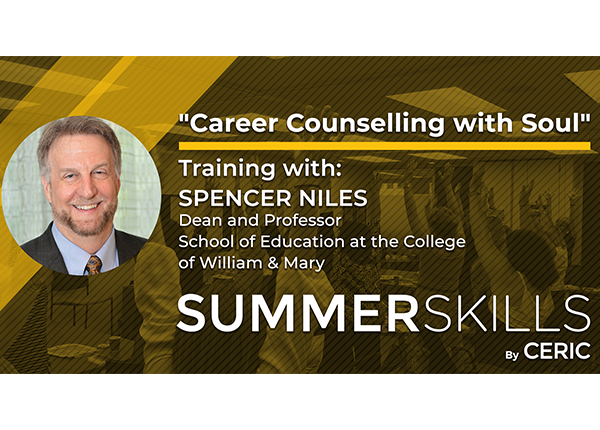
CERIC on the road this spring to share career development knowledge and resources
May 1, 2019
Just announced: Spencer Niles at Summer Skills Academy 2019 – Career Counselling with Soul
May 6, 2019When using multiple assessment tools and strategies, these tips can help weave different elements into a meaningful whole
Deirdre A. Pickerell
When working with clients, career development practitioners (CDPs) are almost always engaged in some form of assessment. From the moment clients first seek services, and as their plans/goals evolve, CDPs assess and re-assess clients’ needs.
CDPs assess work search documents (eg, resume, cover letter) to help maximize their effectiveness and evaluate interview skills to help clients communicate their value to employers. CDPs also assess for factors such as skills, values, interests and personality as they assist clients in identifying new and emerging career opportunities. They assess for employment barriers, learning styles, career beliefs and a host of other factors that might be important when helping clients achieve their goals.

Regardless of the tool being used or what is being assessed, at some point, all these pieces must be brought together into a meaningful whole, helping clients create a vision of the future, set achievable goals and create an action plan. Unfortunately, assessment results can sometimes seem contradictory; either the specific tools don’t align or the client’s story seems disconnected from assessment results. This, in turn, can create confusion for the CDP and the client, making the vision of the future much harder to see.
Building on a series of assessment-related tips (see http://lifestrategies.ca/resources/tip-sheets.cfm) developed by the team at Life Strategies, the following may help CDPs focus on the patterns and themes that emerge during any assessment process.
Read more from Deirdre A. Pickerell on CERIC’s CareerWise website:
The long-sought-after, unrealized dream of a single LMI portal
-
Work within a conceptual framework.
Tools such as the Wheel (Amundson & Poehnell, 1996) and the Hope-Centred Model (Niles, Amundson, & Neault, 2011) provide a lens through which to view each client’s context and presenting issue, helping to select relevant assessments and in the interpretation and integration of results. As with theories and models, working within a conceptual framework “equip[s] us with effective starting places to begin to understand what has already happened, what is happening now, and what needs to happen next” (Neault, 2014, p. 144).
-
Understand and interpret each tool.
To effectively interpret assessment tools, and integrate results across a battery of assessments, CDPs need to fully understand the theoretical foundation of each tool, including how each scale is defined (eg, the Six Factor Personality Questionnaire [SFPQ] defines extraversion differently from the Myers-Briggs Type Indicator [MBTI]) and how scores are presented (eg, t-score, percentile). It is important to engage clients in the interpretation of each tool that is completed; their context and story are important components in understanding assessment results.
-
Don’t over-interpret.
Although CDPs must understand each tool and provide meaningful feedback on specific results, it is also important to avoid over-interpretation. Even norm-referenced tools (ie, where client results are compared against a norm group) are still self-assessments rather than objective measures. At this stage, be comfortable with gaps in information or with questions that might surface and remember that each individual assessment will contain far more information than you need. Be discerning; focus only on the information that is relevant for your specific purpose.
-
Focus on the patterns.
As each tool is interpreted, patterns will begin to emerge. Use Post-it notes, highlighters or other strategies to group together similar concepts. As assessment tools may use different words for similar concepts, remember to focus on the underlying meanings – not just the words.
-
Explore contradictions.
As you explore individual results and identify themes and patterns, some information may not fit together. To begin, consider whether the contradictions make sense based on the tools used; per Tip #2, as extraversion is defined differently on the SFPQ and the MBTI, it is possible for these two assessments to seem to contradict each other, but the underlying meanings may explain any confusing results.
-
Consider other information.
Remember that your clients are more than the sum of their assessment results. Their individual context and story along with their hopes and dreams for the future are of critical importance to the final picture. Take a holistic approach, weaving in information from a variety of other sources, and engage the client in creating a vision of their future.
-
Be prepared for further assessment.
As information is obtained, questions may surface that require additional assessment to explore them fully. However, be sure to recognize when enough is enough; over-assessing doesn’t necessarily lead to additional information. Be mindful of the client’s goal so that each additional assessment is still relevant to the broader purpose. Pay attention to client fatigue, physical comfort and attention span; assessments done while tired may be worthless.
-
Be mindful when reporting results.
How you report results may depend on your purpose, the audience, and who may have access to assessment results and for how long. In some instances, a keep-it-simple approach may be best; in others, a more comprehensive report to support a training or return-to-work plan may be required. Keep jargon and technical language to a minimum, especially if readers aren’t likely to be assessment experts. Always keep the purpose in mind so that reports are focused.
Ethical and effective use of assessment models and tools is a specialized skill. Specific and comprehensive training on individual tools is likely not going to include any meaningful information on how to focus on the patterns and themes across multiple tools or how to incorporate information from a wide variety of sources. As such, CDPs are encouraged to seek coaching, mentorship or other assessment training with a focus on assessment interpretation and integration. There is an “art” to seeing beyond the individual pieces to the story that is being told.
Dr Deirdre Pickerell, CPHR, GCDF-i, is Dean of Academics at Yorkville University’s British Columbia Campus and Vice-President of Life Strategies Ltd. She has been honoured with the 2014 Stu Conger Award for Leadership in Career Development and Career Counselling and the 2006 Human Resources Association Award of Excellence. She has authored/co-authored several articles, training guides and research reports on integrating assessment tools and models into effective career practice.
References
Amundson, N. & Poehnell, G. (1996). Career pathways (2nd ed.). Richmond, BC: Ergon Communications.
Life Strategies Ltd. (2009). Use of assessment processes and tools in career development services (2009). Retrieved from / source http://lifestrategies.ca/projects/assessment-processes-and-tools.cfm
Neault, R. A. (2014). Theoretical foundations of career development (pp. 129-152). In B. C. Shepard, & P. S. Mani (Eds.), Career development practice in Canada: Perspectives, principles, and professionalism. Toronto, ON: CERIC.
Niles, S. G., Amundson, N. E. & Neault, R. A. (2011). Career flow: A hope-centered approach to career development. Boston, MA: Pearson Education.

